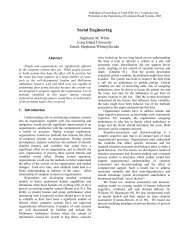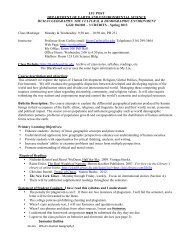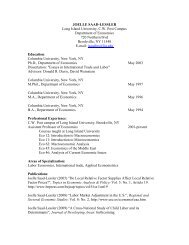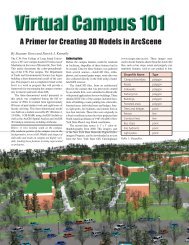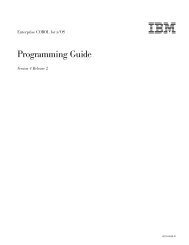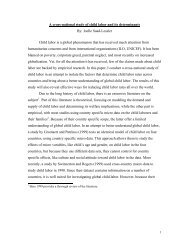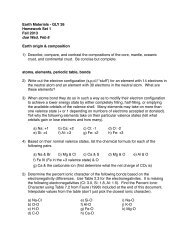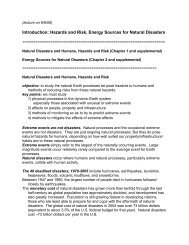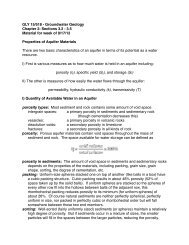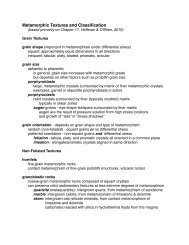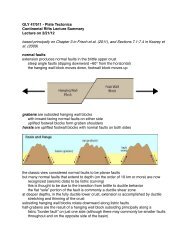Earth Structure and Composition Summary - Myweb @ CW Post
Earth Structure and Composition Summary - Myweb @ CW Post
Earth Structure and Composition Summary - Myweb @ CW Post
Create successful ePaper yourself
Turn your PDF publications into a flip-book with our unique Google optimized e-Paper software.
<strong>Earth</strong>ʼs Origin, Layers, Bulk <strong>Composition</strong>, Tectonic Settings<br />
Correlative readings from Hefferan & OʼBrien (2010) textbook listed in italic.<br />
<strong>Earth</strong> Formation<br />
The <strong>Earth</strong> formed ~4.6 b.y. ago from the solar nebula which contained largely H with<br />
some He <strong>and</strong> H compounds, but also small amounts of “dust” of silicate <strong>and</strong> metallic<br />
particles. The <strong>Earth</strong> <strong>and</strong> the other inner planets were formed principally from the<br />
metallic <strong>and</strong> silicate materials because it was too hot in the inner solar nebula to hold<br />
onto the volatile gaseous elements <strong>and</strong> compounds. <strong>Earth</strong> <strong>and</strong> the inner planets<br />
have metallic, iron-dominated cores <strong>and</strong> rocky, silicate mantles. The metallic <strong>and</strong><br />
silicate materials were able to segregate by density because the early <strong>Earth</strong>ʼs<br />
interior was much hotter than today <strong>and</strong> was partly to largely molten.<br />
<strong>Earth</strong>ʼs Layers (textbook sections 1.2 & 1.3)<br />
The crust: Mohorovicic (1909), studying seismic waves from an earthquake in eastern<br />
Europe, discovered that there is an abrupt increase in seismic wave velocity at a<br />
depth of around 50 km in Yugoslavia. This is called the Mohorovicic seismic<br />
discontinuity or simply the Moho. The velocity increase is caused by a change from<br />
less dense mafic through felsic igneous, metamorphic, <strong>and</strong> sedimentary rocks of the<br />
crust to denser ultramafic rocks of the mantle. The depth to the continental Moho<br />
varies from less than 20 km in rifted continental areas to over 70 km in mountain<br />
belts like the Himalayas <strong>and</strong> Andes. The ocean crust is almost uniformly about 7 km<br />
thick <strong>and</strong> composed almost entirely of mafic rock. The crust formed over billions of<br />
years by melting <strong>and</strong> segregation of lower melting temperature <strong>and</strong> lower density<br />
materials from the ultramafic mantle. The crust is the “scum of the <strong>Earth</strong>.”<br />
The core: Gutenburg (1914) compiled seismic waves recorded at many locations<br />
around the world from many distant earthquakes. From the pattern of the distances<br />
at which seismic waves were <strong>and</strong> were not recorded he recognized that there was a<br />
boundary between the solid mantle <strong>and</strong> a liquid core at a depth of about 2900 km<br />
that stopped S waves (shear waves canʼt travel through liquid) <strong>and</strong> refracted P<br />
(compression ) waves. Later, Lehman (1936) discovered a transition from liquid<br />
back to (probably) solid at a depth of 5150 km based on an increase in P wave<br />
velocity.<br />
What is the core made of? Ans: mostly iron<br />
it is high density<br />
it is common in the solar system (one of the most abundant after H & He)<br />
it will approximately account for the observed seismic velocity<br />
it has magnetic properties that can account for <strong>Earth</strong>ʼs magnetic field.<br />
-90-95% iron, 5-9% nickel, ~1% S (like meteorites) or other light element (O, C)<br />
<strong>Composition</strong>al Layers<br />
crust: felsic to mafic silicates<br />
mantle: ultramafic silicates <strong>and</strong> oxides<br />
core: iron/nickel alloy
Mechanical Layers<br />
lithosphere: strong, rigid crust plus uppermost mantle<br />
asthenosphere: ~100-250 km, mantle near melting temp for that depth (pressure)<br />
" weak, easily sheared, possibly/probably slightly molten (perhaps ~1%)<br />
transition zone: ~410 km & ~660 km olivine changes to denser crystal structure<br />
" olivine above 410 km<br />
" spinel below 410 km<br />
" perovskite below 660 km<br />
lower mantle (also called mesosphere): 660 km - 2900 km, strong ultramafic rock<br />
outer core: liquid iron/nickel<br />
inner core: solid (or crystal mush) iron/nickel<br />
Tectonic Settings (textbook section 1.4 & 1.5)<br />
just a quickie review; detailed discussions of rock formation will come later<br />
Divergent: Midocean Ridges:<br />
two lithospheric plates separate<br />
new crust forms by continuous formation <strong>and</strong> intrusion of mafic magma into fractures<br />
ocean crust eventually receives a thin layer of ocean sediment (muds)<br />
Convergent: Subduction Zones:<br />
oceanic lithosphere sinks back down into the mantle at deep ocean trenches<br />
mafic magma rises to form volcanic arc parallel to trench<br />
sediments scraped off descending plate form accretionary wedge<br />
Convergent: Continental Collisions:<br />
continental crust is not dense enough to subduct - mountain building occurs<br />
metamorphism of rock buried deep under mountain belt<br />
mountains gradually weathered to produce sediments<br />
Hotspot Tracks:<br />
age-progressive chains of volcanoes (best seen on ocean crust)<br />
more-or-less stationary plume of rising, hot mantle<br />
melting as plume material nears base of lithosphere, produces mafic magma



